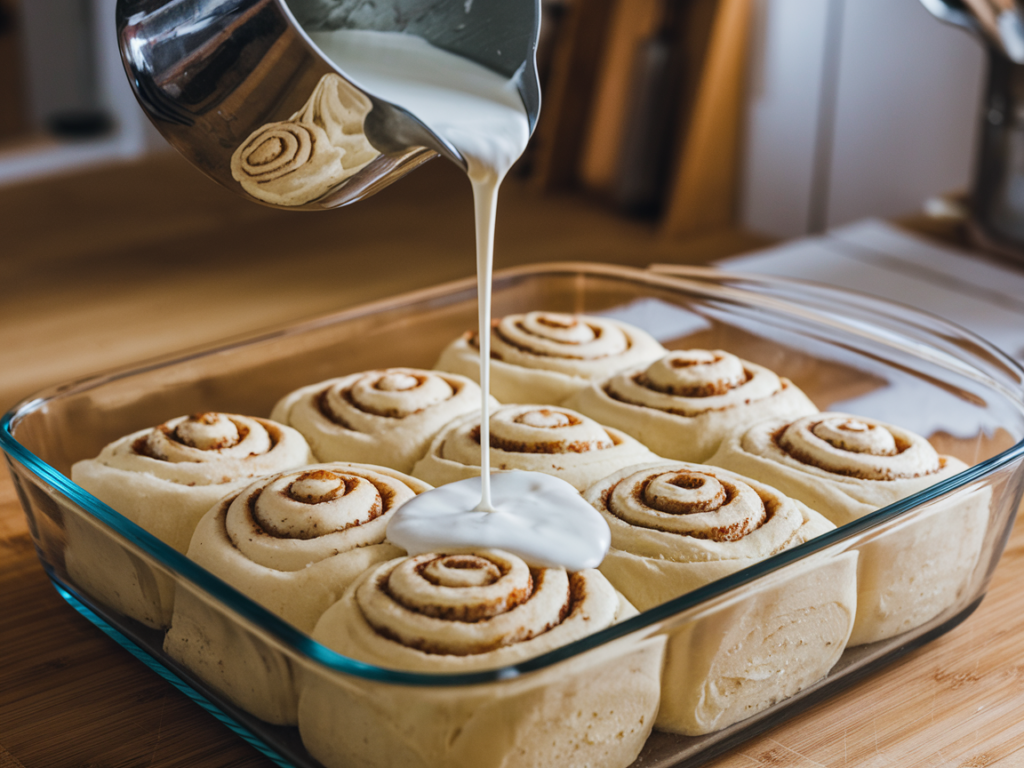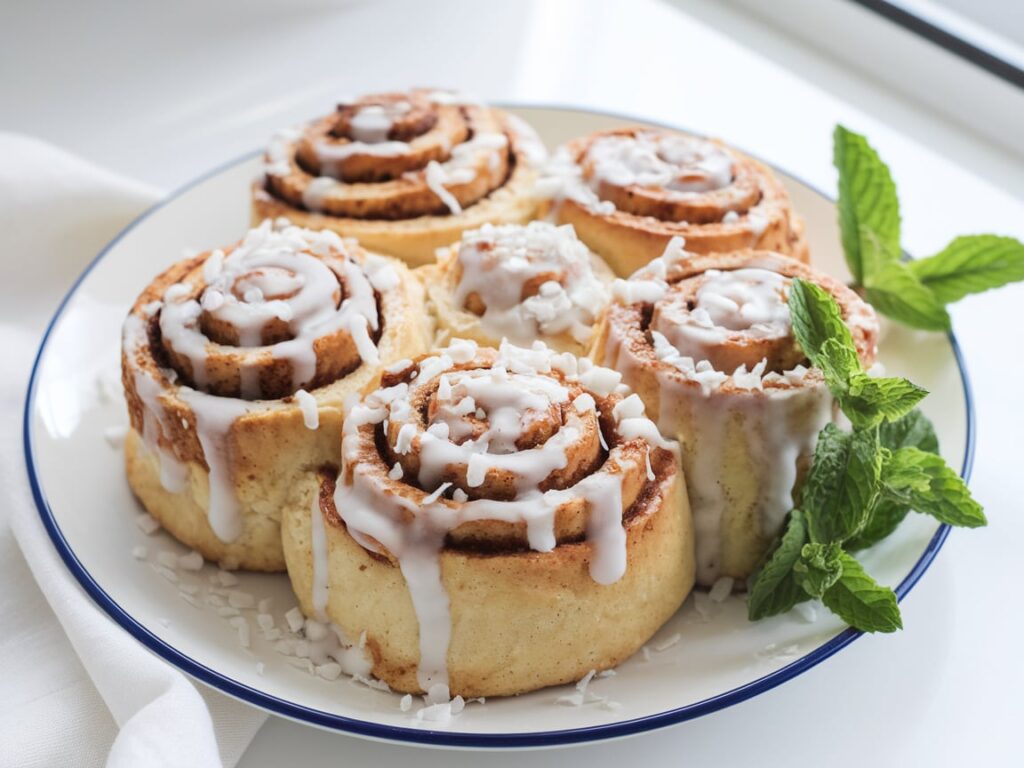The Secret to Gooey Cinnamon Rolls: Heavy Cream Magic
Table of Contents
Hey there, sweet friends! I’m Emma, and if there’s one smell that instantly brings me back to chilly mornings in my grandmother’s cozy farmhouse kitchen, it’s cinnamon rolls baking in the oven. Back then, Grandma would rise with the sun, rolling dough with love, laughter, and flour on her nose. But here’s the twist she swore by and it’s a game changer: heavy cream poured over the rolls before baking.
Yes, really. Heavy cream on cinnamon rolls is the secret to transforming your average breakfast treat into an ooey-gooey masterpiece of comfort. Let me show you how to whip up these nostalgic, indulgent beauties the Spedy way fast, simple, and packed with soul.
Why Heavy Cream?
Adding heavy cream before baking melts into the rolls, making them incredibly soft and rich. The cream seeps into the layers, turning the cinnamon-sugar center into a warm, caramel-like filling. It’s like giving your cinnamon rolls a cozy winter blanket and trust me, your tastebuds will thank you.
Ingredients (Serves 8) Heavy Cream On Cinnamon Rolls
For the Dough:
- 3 ½ cups all-purpose flour
- 1 packet (2 ¼ tsp) instant yeast
- ¼ cup granulated sugar
- ½ tsp salt
- ¾ cup warm milk
- ¼ cup unsalted butter, melted
- 2 eggs
For the Filling:
- ¾ cup brown sugar
- 2 tbsp ground cinnamon
- 5 tbsp unsalted butter, softened
For the Heavy Cream Soak:
- ¾ cup heavy cream (room temperature)
For the Glaze:
- 1 cup powdered sugar
- 1 tbsp melted butter
- 2–3 tbsp milk
- ½ tsp vanilla extract

Instructions For Good Heavy Cream On Cinnamon Rolls
Step 1: Make the Dough
- In a large bowl or stand mixer, combine warm milk, melted butter, eggs, and sugar.
- Add in the flour, yeast, and salt. Mix until dough forms.
- Knead for about 5–7 minutes until smooth and elastic. (Tip: A bit of stickiness is fine!)
- Cover the bowl and let the dough rise in a warm spot for 1 hour or until doubled.
Step 2: Mix the Filling
In a small bowl, mix brown sugar and cinnamon. Set aside. Keep your butter soft and spreadable.
Step 3: Assemble the Rolls
- Punch down the dough and roll it out into a rectangle (about 16×12 inches).
- Spread the softened butter all over the dough.
- Sprinkle the cinnamon-sugar mix evenly on top.
- Roll up the dough tightly from the long edge, then cut into 12 even slices.
Step 4: Add the Heavy Cream
Place rolls in a greased 9×13 baking dish. Pour heavy cream evenly over the rolls, making sure it seeps into the crevices.
🧡 Emma’s Tip: Use room temperature cream cold cream can affect how evenly the dough bakes.
Step 5: Bake!
- Preheat oven to 350°F (175°C).
- Cover the dish with foil and bake for 25 minutes.
- Remove foil and bake another 10–15 minutes, until golden and bubbly.
Step 6: Glaze & Serve
Whisk glaze ingredients until smooth. Drizzle over warm rolls and serve immediately!
Why This Works: A Kitchen Chemistry Moment
Heavy cream not only adds moisture but enhances the caramelization of the cinnamon-sugar swirl. The fat content creates an irresistible texture each bite is buttery, soft, and melts in your mouth.
It’s a trick born in cozy kitchens like my grandma’s and reborn in busy modern homes like mine.
Make It Your Own
Here’s how to tweak your rolls and still keep them Spedy-approved:
- Add Nuts: Sprinkle chopped pecans or walnuts with the filling.
- Go Maple: Use maple syrup in the glaze for a woodsy, warm touch.
- Kids’ Pick: My kids love when we add mini chocolate chips inside!
Storage & Reheating Tips
- To Store: Keep in an airtight container for up to 3 days at room temperature or refrigerate for 5 days.
- To Reheat: Pop a roll in the microwave for 15 seconds or warm in the oven at 300°F for 10 minutes.
💡 FAQ: Your Heavy cream on cinnamon rolls Questions Answered
What does adding heavy cream do to cinnamon rolls?
Heavy cream works its magic by sinking into every swirl and corner, creating ultra-moist, pillowy rolls with a rich, gooey center. It transforms dry or firm rolls into something dreamy like a soft caramel cloud wrapped in cinnamon.
What does heavy cream do to dough?
Heavy cream adds fat and moisture, enriching the dough’s texture and flavor. While we don’t mix it into the dough directly here, pouring it over before baking helps keep the dough from drying out and encourages a soft, melt-in-your-mouth bite.
What is Cinnabon’s secret ingredient?
The not-so-secret star is Makara cinnamon, a sweet, warm variety from Indonesia. It’s what gives Cinnabon that unmistakable aroma and deep flavor. You can mimic it at home with high-quality Saigon cinnamon or even try mixing cinnamon types for a depth of flavor.
How to enhance cinnamon rolls?
Here are Emma’s favorite ways to boost your batch:
Splash of vanilla in the dough or glaze
Citrus zest (orange or lemon) in the icing for a bright twist
Chopped nuts or dried fruit for texture
Double drizzle: glaze once warm and again when cooled
Amazing Vegetable Pizza
Equipment
- Pizza Stone
Ingredients
Pizza Dough
- 1 cup water lukewarm
- 2 cups all-purpose flour
- 1 tsp instant yeast
- 1 tsp salt
- 1 tsp sugar
Pizza Toppings
- red sauce
- 1/4 red onion
- 1/4 green pepper
- 1/4 red pepper
- rosemary
Instructions
- Combine the water, yeast and sugar in a bowl. Rest for 5 minutes.
- Combine the flour and salt.
- Add the yeast mixture and knead until you get a soft ball.
- Place in a bowl and cover. Let rise for 30 minutes.
- Divide the dough and form pizzas.
- Top the pizzas with sauce and vegetables, cook for 15 minutes on the pizza stone.
Notes
Final Thoughts from Emma’s Kitchen For Heavy Cream on cinnamon rolls
There’s something magical about cinnamon rolls with heavy cream like the recipe is giving your family a warm hug. This dish reminds me of my childhood, yet it fits right into our busy lives today. Fast, flavorful, and perfect for creating those slow, sweet moments that matter most.
So, are you ready to pour on the love and bake something unforgettable? Let’s make your kitchen smell like memories in the making.

Ready to try this yourself? Don’t wait grab that carton of cream and start baking your way to cinnamon roll heaven. Trust me, once you taste the difference, you’ll never go back!
To enrich this article and provide readers with additional resources, consider linking to the following related topics:
- Cinnamon Rolls with Apple Pie Filling: Add a fruity twist to your cinnamon rolls by exploring this delightful variation.
- Should You Pre-Cook Apple Pie Filling?: Understand the importance of pre-cooking fillings for baking success.
- Classic Cinnamon Sugar Snickerdoodle Cookies: For fans of cinnamon, these cookies are another must-try recipe.
- Quick Peach Cobbler 3 Ingredients 🍑 (Super Easy & Irresistible)
- White Bean and Pesto Bake – The Weeknight Vegetarian Wonder
- 🌱 One Pot Veggie Pasta – The Easiest Way to Eat More Veggies Tonight
- 🌿 Simple & Satisfying Meals For One Vegetarian: Quick Dinners Without the Meat
- Creamy Peanut Sauce Noodles in 10 Minutes

